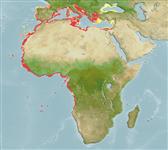Preferred temperature (Ref.
115969): 13 - 19.3, mean 15.5 (based on 193 cells).
Phylogenetic diversity index (Ref.
82804): PD
50 = 0.5001 [Uniqueness, from 0.5 = low to 2.0 = high].
Bayesian length-weight: a=0.01072 (0.00915 - 0.01255), b=3.03 (3.00 - 3.06), in cm Total Length, based on LWR estimates for this species (Ref.
93245).
Trophic level (Ref.
69278): 4.1 ±0.59 se; based on food items.
Resilience (Ref.
120179): Medium, minimum population doubling time 1.4 - 4.4 years (K=0.12-0.19; tmax=7).
Prior r = 0.49, 95% CL = 0.32 - 0.73, Based on 2 stock assessments.
Fishing Vulnerability (Ref.
59153): High vulnerability (60 of 100).
